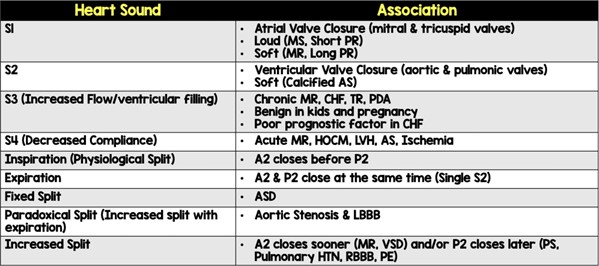The practical nurse (PN) is auscultating a client's heart sounds. Which abnormal heart sound should the PN report to the charge nurse? (Please listen to the audio file to select the option that applies.)
S4.
S2.
S1.
S3.
Correct Answer : A,D
S3 is an extra heart sound that occurs during diastole (the filling phase of the cardiac cycle). It is commonly associated with conditions such as heart failure and volume overload. S3 is often described as a low-frequency, dull, and distant sound heard after S2 (the second heart sound).
B, C- S1, and S2 are the normal heart sounds that are typically heard in all individuals. S1 is the first heart sound, heard as "lub," and is caused by the closure of the mitral and tricuspid valves. S2 is the second heart sound, heard as "dub," and is caused by the closure of the aortic and pulmonic valves. These sounds are normal and expected.
S4 is another abnormal heart sound, which occurs during late diastole and is associated with conditions such as ventricular hypertrophy and reduced ventricular compliance.

Nursing Test Bank
Naxlex Comprehensive Predictor Exams
Related Questions
Correct Answer is B
Explanation
Immune thrombocytopenic purpura (ITP) is a condition characterized by low platelet levels in the blood, which can lead to an increased risk of bleeding and bruising. Patients with ITP are at risk of spontaneous bleeding, and any injury can be potentially serious.
Ensuring the client has minimal clutter in the room is essential to reduce the risk of accidental falls and injuries. Falls and bumps can lead to bruising or bleeding, which can be particularly problematic in individuals with low platelet counts.
Incorrect:
A. Assessing the client for nerve pain or paralysis is important in the overall care of the patient, but it may not directly address the prevention of injury in this situation.
C. Evaluating the client's neurological status after exercising is also essential for assessing their overall health and well-being but may not directly prevent injury.
D. Monitoring the client's blood cell laboratory values, including platelet levels, is crucial for managing ITP, adjusting treatment if needed, and ensuring the client's condition remains stable. However, while important, this action is not directly related to preventing immediate injury in the care facility.
Correct Answer is D
Explanation
This is the correct answer because it allows the practical nurse (PN) to assess the parents' knowledge and understanding of hypospadias, and to provide accurate and relevant information based on their needs.
Hypospadias is a birth defect in boys in which the opening of the urethra is not located at the tip of the penis, but on the underside of the penis or in the scrotum²³. It is a common condition that affects about one in every 250 males at birth. Hypospadias does not resolve on its own and usually require surgical correction to prevent complications such as urinary tract infections, difficulty with urination and sexual function, and psychological distress¹². The PN should explain these facts to the parents and encourage them to discuss their concerns and questions with the health care provider. The PN should also provide emotional support and empathy to the parents, as they may feel anxious or guilty about their child's condition.
Whether you are a student looking to ace your exams or a practicing nurse seeking to enhance your expertise , our nursing education contents will empower you with the confidence and competence to make a difference in the lives of patients and become a respected leader in the healthcare field.
Visit Naxlex, invest in your future and unlock endless possibilities with our unparalleled nursing education contents today
Report Wrong Answer on the Current Question
Do you disagree with the answer? If yes, what is your expected answer? Explain.
Kindly be descriptive with the issue you are facing.
